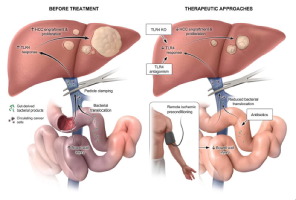当前位置:
X-MOL 学术
›
J. Hepatol.
›
论文详情
Our official English website, www.x-mol.net, welcomes your feedback! (Note: you will need to create a separate account there.)
Effects of the gut-liver axis on ischemia-mediated hepatocellular carcinoma recurrence in the mouse liver
Journal of Hepatology ( IF 25.7 ) Pub Date : 2018-05-01 , DOI: 10.1016/j.jhep.2017.12.025 Lorenzo A. Orci , Stéphanie Lacotte , Vaihere Delaune , Florence Slits , Graziano Oldani , Vladimir Lazarevic , Carlo Rossetti , Laura Rubbia-Brandt , Philippe Morel , Christian Toso
Journal of Hepatology ( IF 25.7 ) Pub Date : 2018-05-01 , DOI: 10.1016/j.jhep.2017.12.025 Lorenzo A. Orci , Stéphanie Lacotte , Vaihere Delaune , Florence Slits , Graziano Oldani , Vladimir Lazarevic , Carlo Rossetti , Laura Rubbia-Brandt , Philippe Morel , Christian Toso

|
BACKGROUND & AIMS
There is growing evidence that liver graft ischemia-reperfusion (I/R) is a risk factor for hepatocellular carcinoma (HCC) recurrence, but the mechanisms involved are unclear. Herein, we tested the hypothesis that mesenteric congestion resulting from portal blood flow interruption induces endotoxin-mediated Toll-like receptor 4 (Tlr4) engagement, resulting in elevated liver cancer burden. We also assessed the role of remote ischemic preconditioning (RIPC) in this context. METHODS
C57Bl/6j mice were exposed to standardized models of liver I/R injury and RIPC, induced by occluding the hepatic and femoral blood vessels. HCC was induced by injecting RIL-175 cells into the portal vein. We further evaluated the impact of the gut-liver axis (lipopolysaccharide (LPS)-Tlr4 pathway) in this context by studying mice with enhanced (lipopolysaccharide infusion) or defective (Tlr4-/- mice, gut sterilization, and Tlr4 antagonist) Tlr4 responses. RESULTS
Portal triad clamping provoked upstream mesenteric venous engorgement and increased bacterial translocation, resulting in aggravated tumor burden. RIPC prevented this mechanism by preserving intestinal integrity and reducing bacterial translocation, thereby mitigating HCC recurrence. These observations were linked to the LPS-Tlr4 pathway, as supported by the high and low tumor burden displayed by mice with enhanced or defective Tlr4 responses, respectively. CONCLUSIONS
Modulation of the gut-liver axis and the LPS-Tlr4 response by RIPC, gut sterilization, and Tlr4 antagonism represents a potential therapeutic target to prevent I/R lesions, and to alleviate HCC recurrence after liver transplantation and resection. LAY SUMMARY
Cancer recurrence can occur after liver resection or liver transplantation for hepatocellular carcinoma (HCC). This study suggests that intestinal venous congestion, which often occurs during liver surgery, favors the translocation of gut-derived bacterial products in the portal vein, thereby facilitating cancer recurrence by enhancing the signaling of Toll-like receptor 4 in the liver. Using a mouse model of HCC recurrence, we show that strategies that (i) reduce bacterial translocation (by gut decontamination, or by protecting the intestine from venous ischemia damage) or (ii) inhibit Tlr4 signaling in the liver, could reduce cancer recurrence.
中文翻译:

肠-肝轴对小鼠肝脏缺血介导的肝细胞癌复发的影响
背景与目的 越来越多的证据表明肝移植缺血再灌注 (I/R) 是肝细胞癌 (HCC) 复发的危险因素,但所涉及的机制尚不清楚。在此,我们测试了以下假设:门静脉血流中断导致肠系膜充血诱导内毒素介导的 Toll 样受体 4 (Tlr4) 参与,导致肝癌负担升高。我们还评估了远程缺血预处理 (RIPC) 在这种情况下的作用。方法 将 C57Bl/6j 小鼠暴露于肝脏 I/R 损伤和 RIPC 的标准化模型,该模型是通过阻塞肝和股血管来诱导的。通过将 RIL-175 细胞注射到门静脉中来诱导 HCC。我们通过研究增强型(脂多糖输注)或缺陷型(Tlr4-/- 小鼠、肠道灭菌和 Tlr4 拮抗剂)Tlr4 反应的小鼠,进一步评估了肠肝轴(脂多糖 (LPS)-Tlr4 通路)在这种情况下的影响. 结果 门户三联征钳夹引起上游肠系膜静脉充血和细菌易位增加,导致肿瘤负荷加重。RIPC 通过保持肠道完整性和减少细菌易位来防止这种机制,从而减轻 HCC 的复发。这些观察结果与 LPS-Tlr4 通路有关,这分别得到了具有增强或缺陷 Tlr4 反应的小鼠所显示的高和低肿瘤负荷的支持。结论 RIPC 对肠-肝轴和 LPS-Tlr4 反应的调节、肠道灭菌、和 Tlr4 拮抗作用代表了预防 I/R 病变和减轻肝移植和切除后 HCC 复发的潜在治疗靶点。概述 肝细胞癌 (HCC) 肝切除术或肝移植后可能发生癌症复发。这项研究表明,肝脏手术期间经常发生的肠静脉充血有利于肠道来源的细菌产物在门静脉中的易位,从而通过增强肝脏中 Toll 样受体 4 的信号传导促进癌症复发。使用 HCC 复发的小鼠模型,我们表明 (i) 减少细菌易位(通过肠道净化,或通过保护肠道免受静脉缺血损伤)或 (ii) 抑制肝脏中的 Tlr4 信号传导,可以减少癌症复发。
更新日期:2018-05-01
中文翻译:

肠-肝轴对小鼠肝脏缺血介导的肝细胞癌复发的影响
背景与目的 越来越多的证据表明肝移植缺血再灌注 (I/R) 是肝细胞癌 (HCC) 复发的危险因素,但所涉及的机制尚不清楚。在此,我们测试了以下假设:门静脉血流中断导致肠系膜充血诱导内毒素介导的 Toll 样受体 4 (Tlr4) 参与,导致肝癌负担升高。我们还评估了远程缺血预处理 (RIPC) 在这种情况下的作用。方法 将 C57Bl/6j 小鼠暴露于肝脏 I/R 损伤和 RIPC 的标准化模型,该模型是通过阻塞肝和股血管来诱导的。通过将 RIL-175 细胞注射到门静脉中来诱导 HCC。我们通过研究增强型(脂多糖输注)或缺陷型(Tlr4-/- 小鼠、肠道灭菌和 Tlr4 拮抗剂)Tlr4 反应的小鼠,进一步评估了肠肝轴(脂多糖 (LPS)-Tlr4 通路)在这种情况下的影响. 结果 门户三联征钳夹引起上游肠系膜静脉充血和细菌易位增加,导致肿瘤负荷加重。RIPC 通过保持肠道完整性和减少细菌易位来防止这种机制,从而减轻 HCC 的复发。这些观察结果与 LPS-Tlr4 通路有关,这分别得到了具有增强或缺陷 Tlr4 反应的小鼠所显示的高和低肿瘤负荷的支持。结论 RIPC 对肠-肝轴和 LPS-Tlr4 反应的调节、肠道灭菌、和 Tlr4 拮抗作用代表了预防 I/R 病变和减轻肝移植和切除后 HCC 复发的潜在治疗靶点。概述 肝细胞癌 (HCC) 肝切除术或肝移植后可能发生癌症复发。这项研究表明,肝脏手术期间经常发生的肠静脉充血有利于肠道来源的细菌产物在门静脉中的易位,从而通过增强肝脏中 Toll 样受体 4 的信号传导促进癌症复发。使用 HCC 复发的小鼠模型,我们表明 (i) 减少细菌易位(通过肠道净化,或通过保护肠道免受静脉缺血损伤)或 (ii) 抑制肝脏中的 Tlr4 信号传导,可以减少癌症复发。



























 京公网安备 11010802027423号
京公网安备 11010802027423号